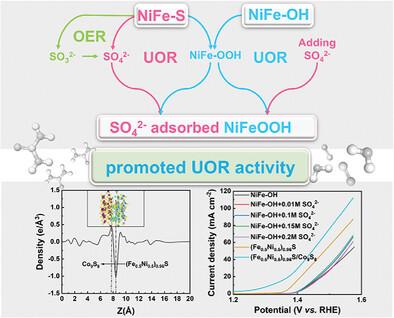Unveiling the Promotion of Sulfides Heterostructure on the Urea Oxidation Reaction: Role of Interface Engineering and Sulfate Adsorption
IF 13
2区 材料科学
Q1 CHEMISTRY, MULTIDISCIPLINARY
引用次数: 0
Abstract
The pursuit of efficient and stable urea oxidation reaction (UOR) electrocatalysts is paramount for the sustainable utilization of renewable energy sources and the treatment of wastewater with urea content. This research introduces the successful fabrication of (Fe0.5Ni0.5)0.96S/Co9S8/NF mesh heterojunction materials, which are replete with interfaces that facilitate enhanced catalytic activity. Benefiting from the electron transfer behavior from (Fe0.5Ni0.5)0.96S to Co9S8, and the promotion of surface adsorption of SO42−, the (Fe0.5Ni0.5)0.96S/Co9S8/NF electrocatalyst has excellent UOR catalytic performance. The experimental characterization and theoretical simulation show that the d-band center/thermodynamic barrier of (Fe0.5Ni0.5)0.96S/Co9S8/NF is regulated by the redistribution of electrons at the heterojunction interface, and the adsorption of SO42− on the surface. The reaction barrier of the adsorption strength/rate-controlling step of urea and reaction intermediates is optimized, which promotes the catalytic kinetics and thermodynamics of UOR, offering a promising strategy for advancing energy and environmental technologies.

求助全文
约1分钟内获得全文
求助全文
来源期刊

Small
工程技术-材料科学:综合
CiteScore
17.70
自引率
3.80%
发文量
1830
审稿时长
2.1 months
期刊介绍:
Small serves as an exceptional platform for both experimental and theoretical studies in fundamental and applied interdisciplinary research at the nano- and microscale. The journal offers a compelling mix of peer-reviewed Research Articles, Reviews, Perspectives, and Comments.
With a remarkable 2022 Journal Impact Factor of 13.3 (Journal Citation Reports from Clarivate Analytics, 2023), Small remains among the top multidisciplinary journals, covering a wide range of topics at the interface of materials science, chemistry, physics, engineering, medicine, and biology.
Small's readership includes biochemists, biologists, biomedical scientists, chemists, engineers, information technologists, materials scientists, physicists, and theoreticians alike.
 求助内容:
求助内容: 应助结果提醒方式:
应助结果提醒方式:


